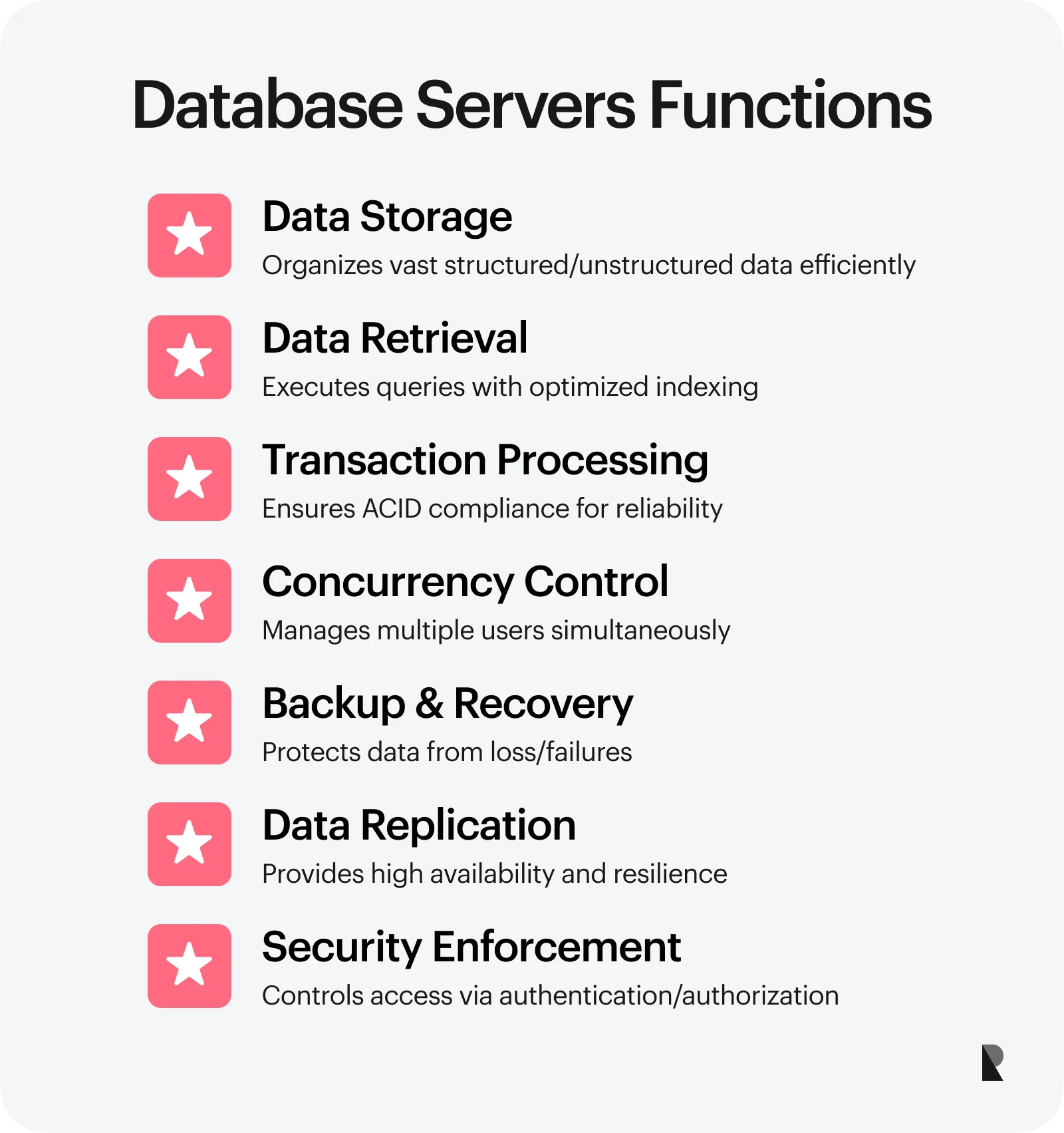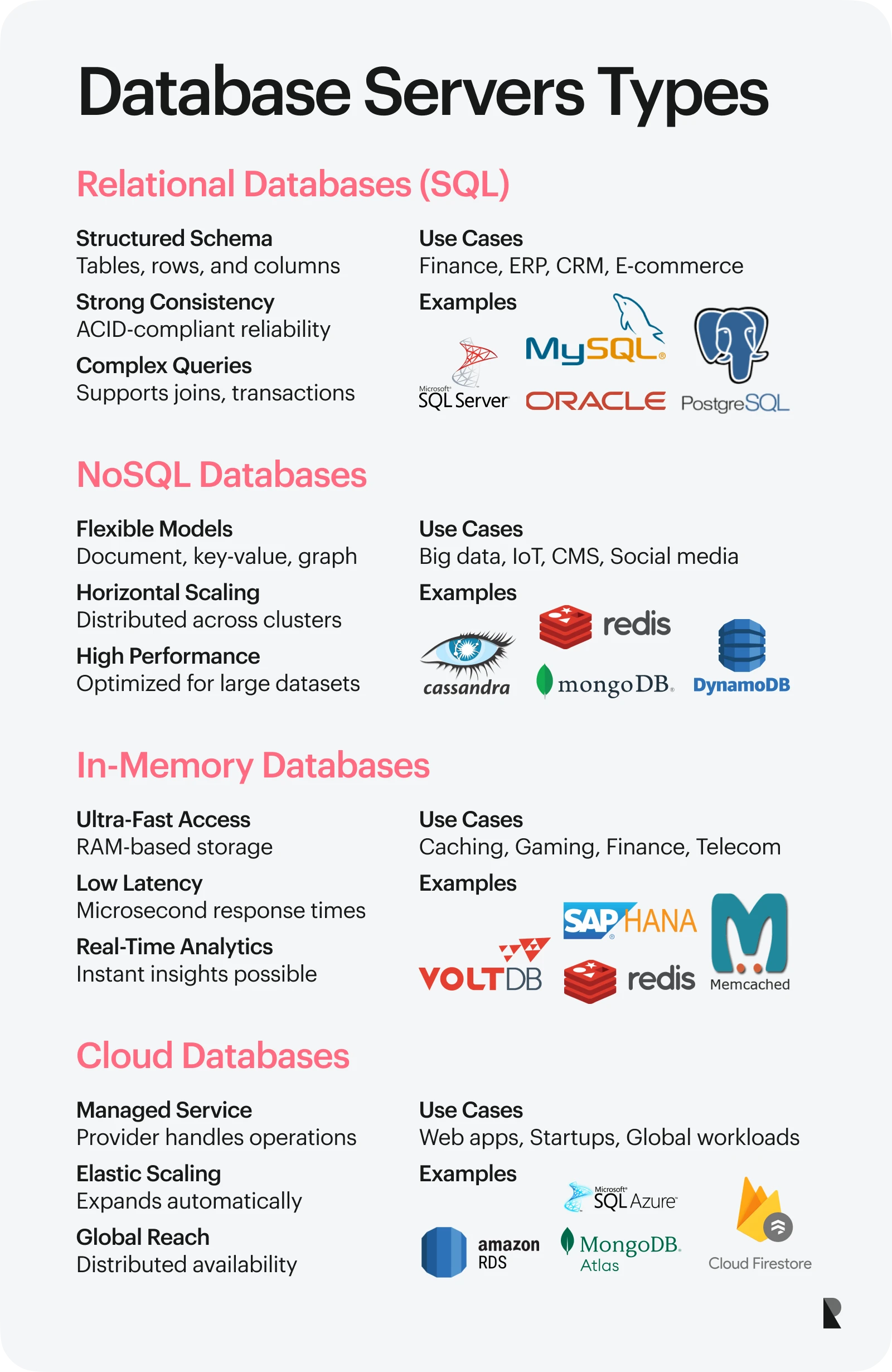
A database server is a dedicated computing system that stores, manages, and delivers data from databases upon request while controlling access to ensure data integrity and security.
A database server is the physical hardware infrastructure and the software system that enables web application development agencies to centralize their data management operations.
Database servers perform several fundamental functions that are essential to modern computing environments:
Data storage: The primary function of a database server is to store vast amounts of structured and unstructured data in an organized manner. This involves allocating physical storage resources and implementing data structures that optimize space utilization while maintaining rapid access capabilities.
Data retrieval: Database servers process queries from applications and users, retrieving specific information based on search parameters. This function relies on sophisticated indexing mechanisms and query optimization techniques to deliver results efficiently, even when searching through millions or billions of records.
Data management: Beyond simple storage and retrieval, database servers handle complex data management tasks, including:
- Transaction processing with ACID (Atomicity, Consistency, Isolation, Durability) properties
- Concurrency control to manage multiple simultaneous users
- Backup and recovery operations to protect against data loss
- Data replication for high availability and disaster recovery
- Security enforcement through authentication and authorization
It's important to distinguish between database software (the DBMS or Database Management System) and the server hardware. While software like MySQL, Oracle, or SQL Server provides the logical functionality, the physical server hardware, comprising processors, memory, storage arrays, and network interfaces, determines performance capabilities, reliability, and scalability limits.

Modern database servers range from small embedded systems supporting individual applications to massive distributed clusters powering global enterprises and cloud services. Regardless of scale, all database servers share the purpose of providing reliable, secure, and efficient data services to the applications and users that depend on them.
Types of Database Servers
Database servers come in various types, each designed to address specific data management needs and use cases. Understanding the differences between these types can help organizations select the most appropriate database solution for their requirements.

Relational databases (SQL)
Relational database servers store data in structured tables with rows and columns, using SQL (Structured Query Language) for data manipulation and querying. These databases implement the ACID (Atomicity, Consistency, Isolation, Durability) principles to ensure data integrity and reliability.
Relational databases excel in scenarios requiring complex queries, transactions, and where data relationships are clearly defined. They use primary and foreign keys to establish relationships between tables, enabling sophisticated data modeling.
Key characteristics: * Structured schema * Strong data consistency * Support for complex joins and transactions * Vertical scaling primarily * Mature technology with established standards
Common use cases: * Financial applications * ERP systems * CRM platforms * E-commerce platforms * Applications requiring complex transactions
Examples: Oracle Database, MySQL, PostgreSQL, Microsoft SQL Server, IBM Db2
NoSQL databases
NoSQL ("Not Only SQL") databases emerged as alternatives to relational databases, designed for specific data models with flexible schemas. They typically prioritize scalability and performance over ACID compliance, though many now offer varying levels of ACID support.
These databases are well-suited for handling large volumes of unstructured or semi-structured data and are built to scale horizontally across distributed systems.
Key types of NoSQL databases:
- Document databases - Store data in flexible, JSON-like documents
- Key-value stores - Simple stores that pair keys with values
- Wide-column stores - Store data in tables with dynamic columns
- Graph databases - Optimize for data whose relationships are represented as a graph
Key characteristics: * Flexible schema design * Horizontal scalability * High performance for specific use cases * Eventual consistency (though many now offer strong consistency options) * Distributed architecture
Common use cases: * Content management systems * Real-time big data applications * IoT data storage * Social media platforms * Product catalogs
Examples: MongoDB, Cassandra, Redis, Couchbase, Neo4j, Amazon DynamoDB
In-memory databases
In-memory database servers store data primarily in RAM rather than on disk drives, dramatically reducing data access times and improving performance for read-intensive applications. While traditionally used for caching and temporary data storage, modern in-memory databases now offer persistence options to prevent data loss during outages.
Key characteristics: * High-speed data access (microseconds vs. milliseconds) * High throughput * Support for real-time analytics * Lower latency than disk-based systems * Often includes data compression techniques
Common use cases: * Real-time analytics * Caching layers * Session stores * Leaderboards and gaming applications * Financial trading platforms * Telecommunications systems
Examples: Redis, SAP HANA, Memcached, VoltDB, Oracle TimesTen
Cloud-based database services
Cloud-based database services provide managed database solutions hosted in the cloud. These services handle infrastructure management, scaling, backups, and other operational tasks, allowing organizations to focus on application development rather than database administration.
Key characteristics: * Reduced operational overhead * Pay-as-you-go pricing models * Automatic scaling and high availability * Built-in backup and recovery * Global distribution options
Common use cases: * Web and mobile applications * DevOps environments * Startups with limited IT resources * Applications with variable workloads * Global applications requiring distributed data
Examples: Amazon RDS, Google Cloud SQL, Azure SQL Database, MongoDB Atlas, Amazon Aurora, Google Firestore
Comparison table
| Type | Key features | Best for | Examples |
|---|---|---|---|
| Relational (SQL) | ACID compliance, structured schema, complex queries, joins | Applications with structured data and complex relationships; financial systems; ERP | MySQL, PostgreSQL, Oracle, SQL Server |
| Document (NoSQL) | Flexible schema, JSON-like documents, horizontal scaling | Content management; catalogs; user profiles; semi-structured data | MongoDB, Couchbase, Firebase |
| Key-value (NoSQL) | Simple data model, extremely fast lookups, high throughput | Caching; session management; real-time recommendations | Redis, DynamoDB, Riak |
| Wide-column (NoSQL) | Column-oriented storage, high scalability, good for writes | Time-series data; IoT; large analytical datasets | Cassandra, HBase, Google Bigtable |
| Graph (NoSQL) | Relationship-focused, native graph storage and processing | Social networks; fraud detection; recommendation engines | Neo4j, JanusGraph, Amazon Neptune |
| In-memory | RAM-based storage, microsecond latency, high throughput | Real-time analytics; caching; leaderboards; financial trading | Redis, SAP HANA, Memcached |
| Cloud-based | Managed services, automated scaling, reduced admin | Web apps; variable workloads; global applications; startups | Amazon RDS, Azure SQL Database, Google Cloud SQL |
Popular Database Server Software
Selecting the right database server software is critical for any web app development company. This choice depends on several key factors, including the data storage type, required scalability, security considerations, performance needs, and budget constraints. For many organizations, partnering with a seasoned web app development agency helps ensure these technical decisions are made with long-term scalability and maintainability in mind.
MySQL
MySQL is one of the world's most popular open-source relational database management systems. Its widespread adoption can be attributed to several key strengths:
- Reliability: MySQL offers robust performance even under high-load conditions
- Community support: With millions of developers worldwide, finding solutions to problems is straightforward
- Ease of use: Its straightforward setup and administration make it accessible for beginners
- Cross-platform compatibility: Runs on virtually all operating systems
- Cost-effectiveness: Free under the GPL license for many use cases
MySQL powers many high-traffic websites, including Facebook, Twitter, and YouTube, demonstrating its capability to handle enterprise-scale workloads. Its integration with PHP makes it particularly popular for web applications, though it's versatile enough for numerous use cases.
PostgreSQL
PostgreSQL (often called "Postgres") has earned a reputation as the most advanced open-source relational database system available. Its distinguishing characteristics include:
- Extensibility: Supports custom data types, operators, and functions
- Standards compliance: Strictly adheres to SQL standards
- ACID compliance: Ensures transaction reliability and data integrity
- Concurrency support: Handles multiple operations simultaneously without read locks
- Advanced features: Includes table inheritance, multi-version concurrency control, and sophisticated query planning
PostgreSQL excels in scenarios requiring complex queries, data integrity, and custom procedures. Organizations like Apple, Instagram, and Cisco rely on PostgreSQL for critical applications. Its ability to handle complex data types and geographical information makes it particularly valuable for scientific applications and location-based services.
Microsoft SQL server
Microsoft SQL Server represents Microsoft's flagship database offering, deeply integrated with the company's technology ecosystem:
- Microsoft integration: Seamless operation with Windows Server, .NET, and other Microsoft technologies
- Business intelligence: Comprehensive suite of BI tools including SSRS, SSIS, and SSAS
- Enterprise focus: Designed for large-scale corporate environments
- Security features: Advanced encryption, auditing, and compliance capabilities
- High availability: AlwaysOn Availability Groups for disaster recovery and fault tolerance
SQL Server is particularly prevalent in enterprise environments that are already invested in Microsoft technology. Its various editions, from Express (free) to Enterprise, allow organizations to scale their database solution as needed.
$ SQLite
SQLite offers a unique approach as a serverless, self-contained database engine:
- Embedded design: The entire database exists as a single file on disk
- Zero configuration: Requires no setup or administration
- Portability: Easily transferable between systems and platforms
- Reliability: Extensive testing ensures data integrity
- Compact footprint: Minimal memory and storage requirements
SQLite is ideal for embedded systems, mobile applications, and scenarios where simplicity is paramount. It powers many smartphone apps, web browsers (for local storage), and IoT devices. While unsuitable for high-concurrency environments, its reliability and simplicity make it perfect for many applications.
SAP HANA
SAP HANA represents cutting-edge in-memory database technology designed for high-performance analytics and processing:
- In-memory architecture: Stores data primarily in RAM for exceptional speed
- Real-time analytics: Processes complex queries on large datasets instantly
- Column-store design: Optimized for analytical workloads
- Hybrid processing: Handles both transactional and analytical workloads simultaneously
- Advanced compression: Reduces memory footprint while maintaining performance
SAP HANA powers many Fortune 500 companies' ERP and business intelligence systems. Its ability to process massive datasets in real-time enables advanced analytics and reporting that would be impractical with traditional database architectures.
IBM Db2
IBM Db2 delivers enterprise-grade database capabilities with particular strengths in performance and analytics:
- Scalability: Handles everything from small applications to massive enterprise workloads
- AI integration: Built-in machine learning capabilities
- Hardware optimization: Specially tuned versions for IBM hardware
- Workload management: Sophisticated resource allocation for mixed workloads
- High availability: Advanced clustering and disaster recovery options
DB2 is robust in financial services, healthcare, and other sectors requiring absolute reliability and performance. Its editions serve different market segments, from small businesses to global enterprises.
MariaDB
MariaDB began as a fork of MySQL but has evolved into a distinct database system with enhanced features:
- MySQL compatibility: Drop-in replacement for MySQL in most cases
- Enhanced performance: Improved query optimizer and storage engines
- Additional storage engines: Support for specialized workloads
- Open development model: Community-driven with transparent roadmap
- Enterprise features: Advanced security, scalability, and monitoring tools
Organizations like Wikipedia, Google, and Alibaba use MariaDB because it is MySQL compatible and offers improved performance and features. It offers a compelling alternative for organizations considering MySQL, particularly those concerned about Oracle's stewardship of MySQL.
MongoDB Atlas
MongoDB Atlas delivers MongoDB's document database capabilities as a fully managed cloud service:
- Document model: Flexible schema for semi-structured data
- Cloud-native: Designed for modern distributed applications
- Multi-Cloud support: Runs on AWS, Azure, and Google Cloud
- Automated operations: Handles scaling, backups, and updates automatically
- Integrated analytics: Built-in data visualization and exploration tools
MongoDB Atlas is well-suited for modern web and mobile applications with changing data requirements. Companies like Toyota, Bosch, and HSBC use MongoDB Atlas to build flexible, scalable applications that can evolve rapidly. Its pay-as-you-go pricing model makes it accessible to organizations of all sizes.
Database Server Hardware
A database server's hardware configuration is the foundation for all database operations. Unlike general-purpose servers, database servers have unique hardware requirements that directly impact performance, reliability, and scalability. Proper hardware selection can mean the difference between lightning-fast queries and frustrating bottlenecks.
CPU considerations
The processor is the brain of your database server, handling query execution, data calculations, and transaction processing. When selecting CPUs for database workloads:
- Core count vs. clock speed: Database workloads benefit from both. More cores handle concurrent connections better, while higher clock speeds improve single-thread performance for complex queries.
- CPU cache: Larger L2/L3 caches significantly improve database performance by reducing memory access latency.
- Instruction set extensions: Modern CPUs with advanced instruction sets (like Intel's AVX-512) can accelerate certain database operations.
- NUMA architecture: Non-Uniform Memory Access awareness is crucial for optimal memory allocation for multi-socket servers.
Most enterprise database servers utilize multi-socket configurations with server-grade processors (Intel Xeon or AMD EPYC) that provide the necessary processing power, reliability features, and memory bandwidth.
RAM importance
Memory is the most critical component for database performance. Sufficient RAM allows a database to:
- Cache frequently accessed data, reducing disk I/O
- Support more concurrent connections
- Handle larger query execution plans
- Buffer write operations
Memory considerations include: * Capacity: Ideally, the entire working dataset should fit in memory. This might mean hundreds of gigabytes or even terabytes of RAM for large databases. * Speed and type: Higher frequency DDR4/DDR5 RAM with ECC (Error-Correcting Code) is standard for database servers to ensure data integrity. * Memory channels: Maximizing memory channels improves bandwidth, which is crucial for data-intensive operations. * Memory-optimized configurations: In-memory databases like SAP HANA require specialized memory configurations with higher capacity and bandwidth.
Storage Options
Storage subsystems determine how quickly data can be read from and written to disk, directly impacting database performance:
SSD vs. HDD comparison:
| Feature | Solid state drives (SSD) | Hard disk drives (HDD) |
|---|---|---|
| Speed | 10-100x faster for random I/O | Slower, mechanical limitations |
| Latency | Microseconds | Milliseconds |
| Cost | Higher /GB | Lower /GB |
| Durability | Limited write cycles | Mechanical wear |
| Use case | High-performance OLTP, critical data | Archival, large datasets, backups |
Modern database deployments typically use tiered storage approaches:
- NVMe SSDs: For transaction logs and frequently accessed data
- SATA/SAS SSDs: For primary data storage
- HDDs: For historical data, backups, or cold storage
Enterprise storage solutions often implement RAID configurations (typically RAID 10 for databases) to balance performance and redundancy.
Conclusion
A database server is the backbone of modern digital systems, powering everything from simple web apps to large-scale enterprise and cloud platforms. Ensuring fast, reliable, and secure data management enables businesses to operate efficiently and scale seamlessly.
As data grows in volume and complexity, database servers will remain vital, evolving with trends like cloud computing, AI integration, and real-time analytics to shape the future of digital infrastructure.
Sep 5, 2025
